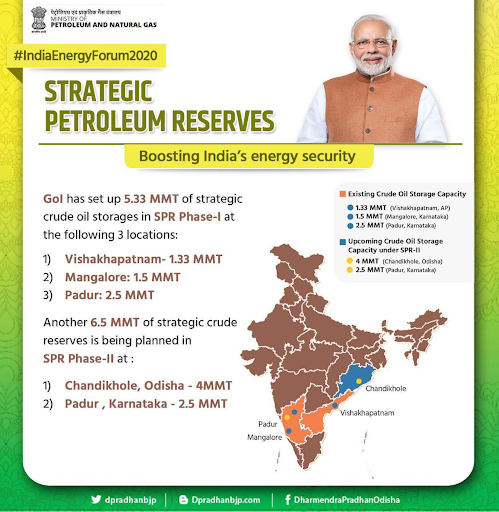Strategic Crude Oil Reserves
What are SPRs?
- Strategic Petroleum Reserves (SPR) are huge stockpiles of crude oil stored in the underground rock caverns (considered safest for storage of Hydrocarbons) to tackle emergency situations and allow a country to tide over short-term supply disruptions.
- They represent a defence against any event of downfall in future oil production, including physical or economic actions which disrupt any part of the production process from exploration and development through refining.
Importance of Strategic Petroleum Reserves (SPR) programme
- The Gulf War in 1990 led to a sharp rise in oil prices and a huge increase in India’s imports. During the post-1991 Indian economic crisis, foreign exchange reserves could barely finance three weeks’ worth of imports, while the government came close to defaulting on its financial obligations. India was able to address the crisis through policies that liberalized the economy.
- However, India continued to be affected by volatility in oil prices. In 1998, former Prime Minister Atal Bihari Vajpayee administration proposed the creation of petroleum reserves as a long-term solution for managing the oil market.
Current Status
- In India, Strategic Petroleum Reserves are maintained by Indian Strategic Petroleum Reserves Limited, a Special Purpose Vehicle – wholly owned subsidiary of Oil Industry Development Board under the Ministry of Petroleum & Natural Gas.
- Strategic crude oil storages are situated at Mangalore (Karnataka), Visakhapatnam (Andhra Pradesh) and Padur (Karnataka) as per Phase I of India’s SPR programme. They have fuel storage of a total 5.33 MMT (Million Metric Tonnes) and all the storage facilities have been filled with crude oil. As per the consumption pattern of 2019-20, the total capacity is estimated to provide for about 9.5 days of crude oil requirement.
- In addition, Oil Marketing Companies (OMCs) in the country have storage facilities for crude oil and petroleum products for 64.5 days, thus the current total national capacity for storage of crude oil and petroleum products currently is 74 days.

- The global practice is to maintain strategic reserves of at least 90 days of oil imports.
Why in the news?
- Under the second phase of the Petroleum Reserves programme, the government has recently approved the setting up of two additional commercial-cum-strategic facilities with a total storage capacity of 6.5 MMT underground storage at Chandikhol in Odisha (4 MMT) and Padur (2.5 MMT), on Public-private partnership (PPP) Mode.
- The request for proposal for building these storage facilities is under finalisation.
- This would raise India’s strategic reserve capacity to 11.83 MMT, and in times of crisis, India can manage its oil requirement for a specific time period.
Reference:
- https://newsonair.com/2021/07/28/govt-approves-two-more-new-strategic-oil-reserves-of-capacity-6-5-mmt/
Subscribe
Login
0 Comments
